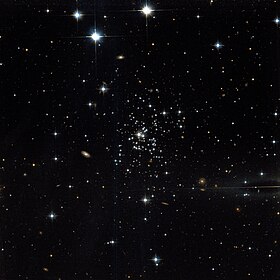| Palomar 1 | |
|---|---|
 Palomar 1 by Hubble Space Telescope; 3.3′ view | |
| Observation data (J2000 epoch) | |
| Class | XII |
| Constellation | Cepheus |
| Right ascension | 03h 33m 20.04s[1] |
| Declination | +79° 34′ 51.8″[1] |
| Distance | 36.5 ± 4.2 kly (11,200 ± 1,300 pc)[2] |
| Apparent magnitude (V) | +13.18 |
| Apparent dimensions (V) | 2.8′ |
| Physical characteristics | |
| Radius | 15 ly[3] |
| Estimated age | 6.3 to 8 Gyr[2] |
| Notable features | – |
| Other designations | LEDA 13165[4] |
Palomar 1 is a globular cluster part of the Palomar group in the constellation Cepheus in the halo possibly in the Outer Arm of the Milky Way galaxy. First discovered by George O. Abell in 1954 on the Palomar Survey Sky plates,[5] it was catalogued as a globular cluster. At 6.3 to 8 Gyr, it is a very young cluster when compared to the other globular clusters in the Milky Way.[2] It is a relatively metal-poor globular with [Fe/H] = −0.60.[6] It is likely that Palomar 1 has a similar evolutionary history to the Sagittarius dwarf companion globular Terzan 7, that is, it may have once been associated with a dwarf spheroidal galaxy that was later destroyed by tidal forces.[6]
- ^ a b Cite error: The named reference
aj140_6_1830was invoked but never defined (see the help page). - ^ a b c Cite error: The named reference
rosenbergwas invoked but never defined (see the help page). - ^ distance × sin( diameter_angle / 2 ) = 15 ly. radius
- ^ Cite error: The named reference
simbadwas invoked but never defined (see the help page). - ^ Abell, George O. (1955). "Globular Clusters and Planetary Nebulae Discovered on the National Geographic Society-Palomar Observatory Sky Survey". Publications of the Astronomical Society of the Pacific. 67 (397): 258. Bibcode:1955PASP...67..258A. doi:10.1086/126815.
- ^ a b van den Bergh, Sidney; Mackey, A. D. (2004). "Globular clusters and the formation of the outer Galactic halo". Monthly Notices of the Royal Astronomical Society. 354 (3): 713–719. arXiv:astro-ph/0407346. Bibcode:2004MNRAS.354..713V. doi:10.1111/j.1365-2966.2004.08228.x. S2CID 15407602.